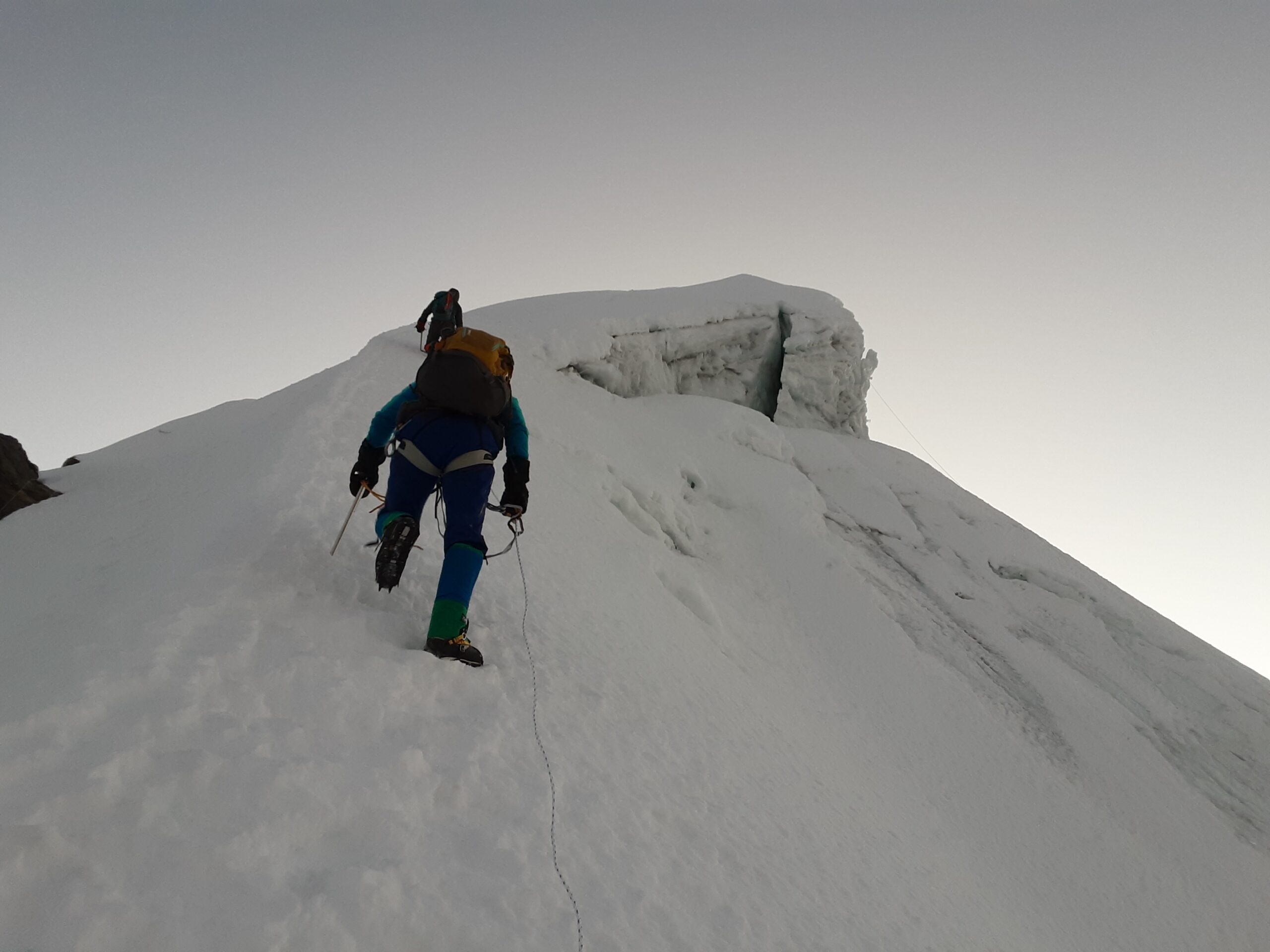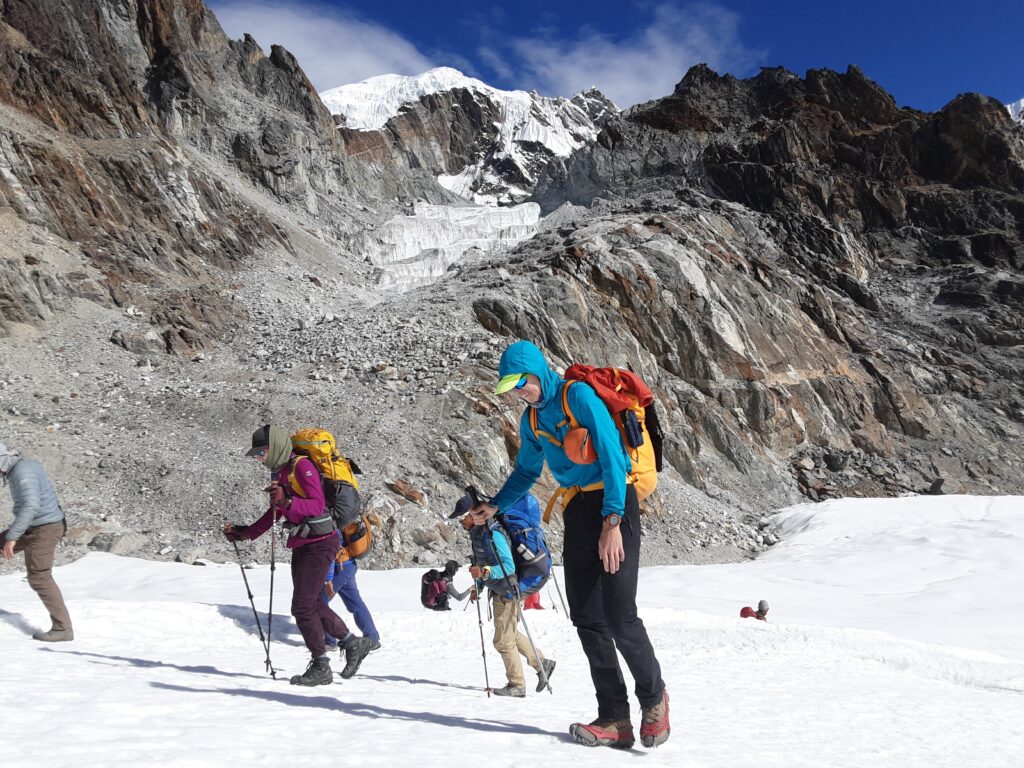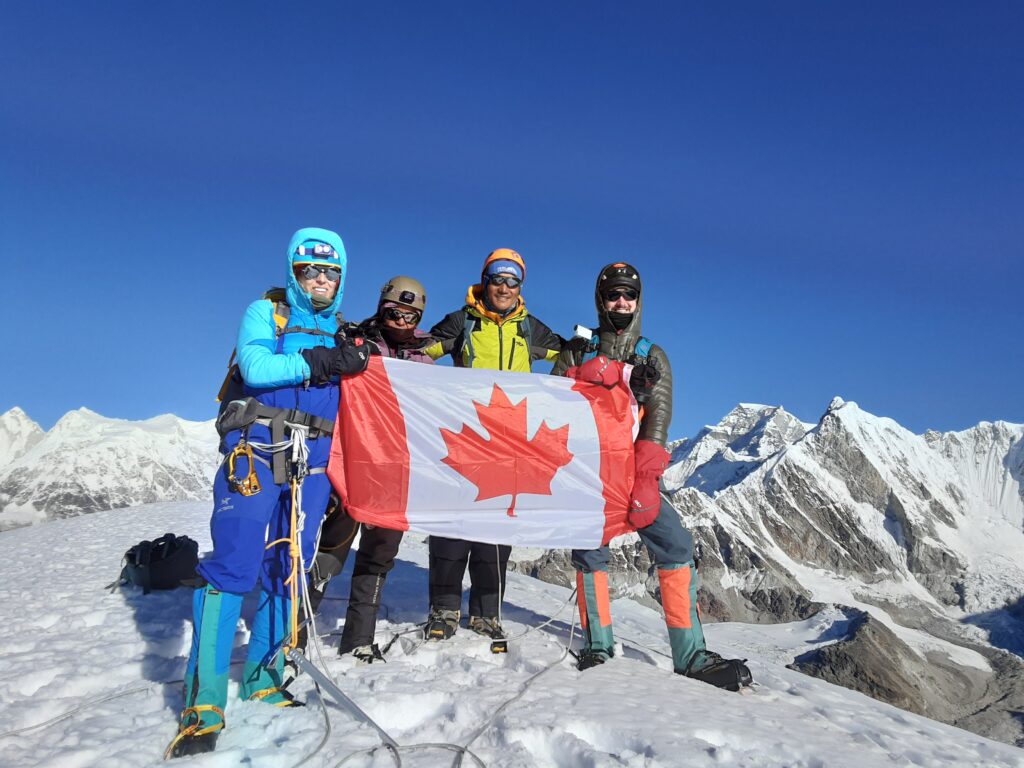Destination
Nepal

Nirekha Peak climbing is a paradise for mountain lovers – both for beginners and professional climbers. Nirekha peak climbing is a must-visit peak in Nepal that fulfills the desire for great adventure among climbing enthusiasts. Nirekha peak lies down in a different bed than the most mediatic peaks. Nirekha Peak (6,069 meters high) is very close to peaks such as Everest and Cho-Oyu.
Nirekha Peak, like a magnet, attracts climbers from all over the world with its fantastic nature, dizzying cliff and landscapes, birdsong, and fresh air.
Nirekha Peak, located in the Khumbu region, is roughly in line with Lobuche Peak and immediately east of Cho La Col and a few hundred meters above Cho La Pass. This mountain has recently been opened as a trekking peak by the NMA in Nepal. In April 2003, the first ascent was made by Matt Florets and Greg Valentine. An all-female team made the second successful ascent in October 2003.
The summit consists of two summit pyramids, the north summit, and the south summit. The North Summit is more accessible but requires a tricky crevasse to cross. The South Summit requires a strenuous part on an incline in the ascent is up to 50° steep ice. It is unclear which of the two peaks is higher. The ascent is relatively easy, although it requires technical equipment such as ice axes, crampons, ice screws, jumar, and some fixed rope sections. Only experienced climbers should attempt to climb the summit of Nirekha, which requires some technical mountaineering skills. It is a physically demanding ascent for all climbers in good shape and with a desire for a great adventure.
There are two climbing routes at Nirekha Peak; one starts from Kangshung Base Camp (5250m) and takes about 9 hours, and the other from Lake Base camp (5050m) and takes about 11 hours. The climb from the Kangshung side is preferred as it is easier and shorter. The ascent mostly takes place in ice and snow and requires crossing deep glacial crevasses and overcoming steep ice slopes.
From the Chola Pass Base Camp, a narrow trail heads north, and just before the glacier is Nirekha Base Camp. The glacier up to Cho La Col on the Kangshung side is relatively safe, with only a few mostly harmless crevasses. It is a 2-3 hour walk from Base Camp to High Camp. The climbing route goes up the southwest face, and it is made of hard blue ice. The Nirekha summit ridge is a long way up, and there are several deep crevasses.
Despite the relatively small difference in altitude, the mountain requires excellent physical condition and acclimatization. You have views of one of the most beautiful landscapes in the Himalayas from the summit. From the top you can gaze at Mt. Everest, Lhotse, Nuptse, Cho Yu, Gyachung kang, Pumori, Makalu, Khang Tega, Thamserku, Tawoche, Ama Dablam, Cholatse and many others.

If you are a connoisseur of mountain climbing, adventure, and challenge, then Nirekha peak is for you. The average cost per person to climb Mount Nirekha ranges from $3000-to $4000. A one-month valid climbing permit should be obtained from NMA (Nepal Mountaineering Association) at the fee of $250 per person during the spring season, $125 per person in autumn, and $70 per person in the winter and summer season.
The best time to explore the Nirekha peak in its full glory is the spring season ( March to May), with a haze hovering in the air covering the mountain Nirekha. It is at this time that glorious rhododendrons bloom. The pink and red flowers on the trees paint the harsh beauty of the Himalayas. A striking feature of the spring months is the stability of the weather and the transparency of the air. Daytime temperatures in the mountain can reach +15.
The second favorable time is the autumn season ( September to early December) when the air and visibility are clearer. It is due to the fact that stable weather conditions are established in the mountain, and the amount of precipitation decreases. Rain is still likely, but most often, in the evening, the snow has already completely melted, and the amazing starry sky above will enchant you at night.
Though the summit is open in the winter season ( late December to February) and summer season ( June to August), these are unfavorable as the daytime temperature can range between 7 to 15 degrees Celcius. At night, the zero-degree temperature will welcome you. Summer is the season of monsoons with endless intense rains.

Your trip begins after landing at one of the most dangerous airports in the world, Lukla airport. A trek through beautiful ethnic Sherpa villages such as Phakding, Namche Bazaar, Dole, Macchermo, and Gokyo, accompanied by the Dudh Koshi river and several waterfalls along the way, will make your trip worth remembering. During your expedition, one of the most important stops will be the Everest Base camp with a climb on Kala Patthar, which will be your vantage point.
Welcome to Kathmandu! Kathmandu is the capital and cultural center of Nepal. You will be assisted to move to your hotel, and a brief trekking meeting will take place in the evening to provide you with the information regarding your expedition.
A short 35 minutes early morning flight will take you to Lukla. As you set foot on Lukla, you will immediately start your trek to Phakding. Take a leisurely walk through Chaurikharka and then continue down to Dudhokoshi Ghat. Walk along the Dudukoshi River to Phakding and stay here for altitude adaptation on the first night.
After having breakfast at Phakding, get ready for a 5-6 hours trek to Namche Bazaar, the largest Sherpa village. On this day, you will first cross the long suspension bridge, cross the Dudukoshi River, and walk for about 2 hours in the beautiful pine forest to Monjo. You will follow the route down the Dudukoshi River to Jorsale. There are two bridges on the mountain road along the river, one of which is the Hillary Suspension Bridge. Everest will be noticeable for the first time on this trip at Namche Bazaar, and the magnificence of the climb will make Trekker worth the climb.
Namche is a good place to rest. An optional 2-hour hike to Everest Viewpoint will help you get used to the height quickly and highly. If not, why not take a walk in Namche Bazaar. Take a look at the Sherpa Museum, where you can get an overview of the Sherpa culture and mountaineering history.
Breakfast at Namche bazaar for refueling and trek to Dole with the breathtaking landscapes of Everest, Nuptse, Lhotse, Ama Dablam, Thamserku, Kwande. Dole, the accommodation for the day, is famous as the most beautiful place in the Everest Mountains. Follow the chanting and prayers of the resident Buddhist monks on a guided tour of the monastery grounds to cultivate your spirit.
The day’s trek starts by walking along the Dudh Koshi river. The small village Macchermo lies to the north of Dole village. A marvelous view of the Ngozumpa glacier will accompany you on the way.
The path becomes rougher and climbs over a boulder field next to the tongue of the Ngozumpa glacier, eventually leading to a series of beautiful lakes.
A rest day at Gokyo with an option for 3-hour climb to the scenic mountain Gokyo Ri with rewarding views of Everest, Makalu, Cho Oyu, and other Himalayan giants.
Your trek begins with a descent to Gokyo lake, then crosses the glacier with relative ease through a tangle of moraines and crevasses.
A 5-6 hrs trek from Thangnak will take you to Nirekha Base Camp. However, there are two routes: via Kanshung base camp and lake base camp. You will hike through the easiest route, the Kanshung base camp.
This rest day can be used with some physical and technical training in using an ice ax, jumars, and tying knots.
Today is the important day of your expedition, a 2-3 hrs trek will take you to the High Camp. You will walk north and follow a path up the steep slope with rock slabs and flat territory just below the glacier.
Today is the day you were waiting for throughout your excursion. An early morning start with a spectacular sunrise view on the path will make your 9-10 hours hike more effortless and memorable. At the summit, you can have some majestic views of Everest, Lhotse, Nuptse, and Ama Dablam. After spending some time on the summit, you will head down and reach the base camp.
You will have to climb over huge boulders on a steep, strenuous snow slope that will take you in two hours to the top of the Chola Pass to a flat glacial plateau with breathtaking views East and West. Descend the snowy glacier to the beautiful valley of Dzongla.
A short stage will take you to Gorakshep, very close to Mount Everest Base Camp. The straight mountain road leading to Everest Base Camp is a very steep road. Rugged sandhills, moraines, and unlayered glacier debris stand in front of you. On your way to your destination, you’ll approach the famous Khumbu Glacier and ice falls on the slopes of Everest. Once you reach the base camp, you may have the opportunity to meet climbers aiming to reach Mount Everest. Take a picture of this breathtaking beauty and stunning sight.
On this day, you will walk toward Kala Patthar (meaning black rock) before dawn to see the blazing sunrise over Everest. The first light of the day illuminates the spectacular scenery of Nuptse, Chanze, and Lhotse. This is probably the best time to capture the spectacular scenery of Everest and the surrounding peaks on your entire itinerary. If you keep pace lightly when descending the mountain, trekking on this day will be easier.
The day’s trek starts by walking through the Shakunage Forest leading to Dingboche. After passing the rocky walls of the valley, cross the plains leading to Tyangboche, the largest Sherpa village in the mountains. Enjoy lunch with the locals while observing the traditional Sherpa village.
It takes an hour counter-intuitively to cross one hill, but the turn from Tangboche is mostly downhill. When you arrive in Namche in the afternoon, lie down early in bed for the final day of this trek.
After breakfast, head to the Hillary Suspension Bridge and pass through some of the local villages. The final destination of this trip, Lukla’s Teahouse, arrives from evening to night. This will be the last night of this trek, which can be bittersweet.
In the morning, take a brief flight from Lukla to Kathmandu, the departure and arrival point of your trip. Upon arrival in Kathmandu, work slowly on your own mind and body that have achieved remarkable achievements.
It is worth spending the day sightseeing at Durbar Square, Swayambhunath, Pashupatinath, and Boudha Stupa.
A departure day and farewell with a heavy heart to Kathmandu and return back home.
Stay and explore places